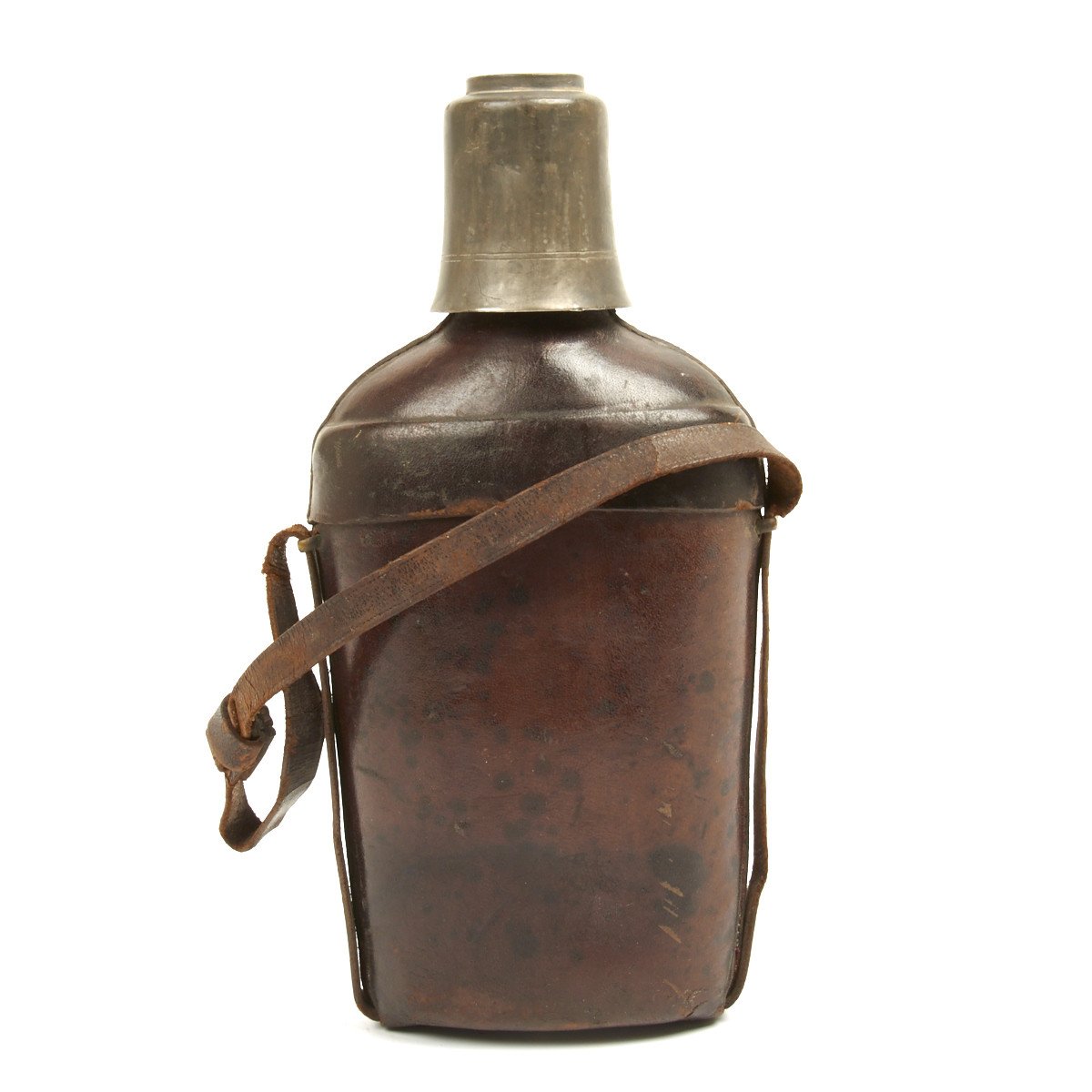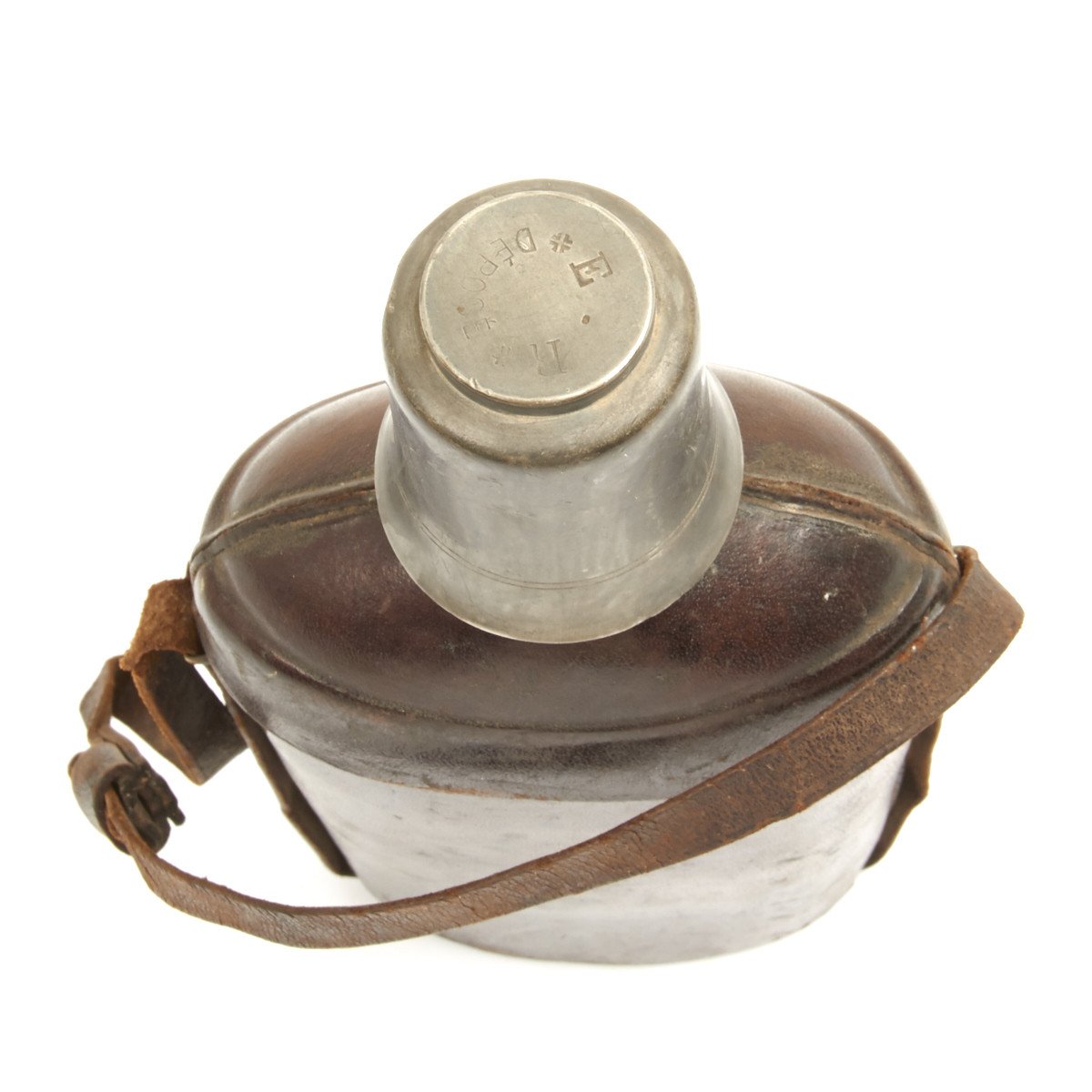Original Belgian WWI Air Ace Named Spirit Flask Original Items
$ 595,00 $ 178,50
Original Item: Only One Available. This is a high quality very fancy fully leather covered spirit flask complete with screw-on pewter cup and cap of continental manufacture. Both flask and cup have maker markings and proof marks confirming capacity and origin.
The cup is engraved on the exterior:
W.O.F. J. COPPENS
QUARTRIEME ESCADRILLE
Willy Omer Francois Jean Coppens was born in Belgium in 1892. He joined the Army in 1912 with 1st Regiment of Grenadiers but in after the invasion by Germany in 1914 transferred to the Motor Machine Gun Corp. In early 1915 he shipped over to England to learn to fly returning in December and on the 9th of that month he received his Pilot’s certification.
He trained further in France and joined the 6th Escadrille as Sergeant 1st Class on 8th April 1917. Later that month he joined the QUARTRIEME ESCADRIILE and was assigned to fly in a Nieuport Squadron. He was the first man in his squadron to be given a HANRIOT HD 1s fighter and went on to fly into the history books.
In August 1917 he was promoted to Adjutant and in April 1918 he shot down his first enemy aircraft thereafter in just a few months up until October 1918 he shot down a total of three enemy aircraft and a staggering 34 enemy observation balloons. His total was as many victories as Belgian’s next five aces combined.
On October 14th 1917 he was severely wounded by an incendiary bullet smashing his left
tibia and severing the artery. His plane crashed near Diksmuide and he was rushed to hospital where his left leg was amputated.
He was Belgium’s best WWI air ace and received a knighthood for his service. He died in 1940.
This is a lovely personal item of real quality from a true hero!
History of the Aviation Militaire Belge in WWI:
By the time of Belgium’s entry into the First World War on 4 August 1914, the military aviation branch, now called the Aviation Militaire Belge, consisted of four squadrons, each consisting of four 80-horsepower Henri Farman aircraft, although Escadrilles III and IV were still forming. A truck was assigned to each squadron, along with a fifth truck serving as a mobile workshop. Each squadron had a commander, five pilots, and six observers, with all officers seconded from parent units. As a result, most of the new aviators were from the Engineers and Artillery components of the Belgian armed forces. As the war began, a fifth squadron was created, staffed with civilian pilots called to the colors and equipped with Bleriots.
Sous Lieutenant Henri Crombez flew one of the first war patrols, in a Deperdussin racer on 4 August 1914 above Liège. Adjutant Behaeghe was the first to engage an enemy, a few days later. On 26 September, the Belgian air crew of Sous Lieutenant de Petrowski and Sergeant Benselin mortally wounded a German pilot with a rifle bullet and forced his Taube to land at Sint-Agatha-Berchem; if they had submitted a claim for this victory, its approval would have marked history’s first air-to-air combat victory.
On 3 January 1915, two machine guns supplied by British were fitted to two Belgian aircraft, making a dual effort against the foe possible; these were Belgium’s first dedicated fighter planes. In February, thirteen of the Belgian airmen flew 28 offensive patrols; their first dogfight was fought on the 26th, with ten Albatroses against three Belgian Farmans. On 26 March, Sous Lieutenant Boschmans sent a German two-seater into a steep dive when he seemed to hit the pilot; the German was not seen to either crash or land. This was the Belgian aviators’ first victory claim.
In April, Lieutenant Fernand Jacquet mounted a machine gun on his pusher aircraft and sought out the enemy. On the 17th, he scored Belgium’s first confirmed aerial victory, sending an Albatros reconnaissance aircraft down in flames over Roeselare. Apparently at about the same time, Adjutant José Orta and Sous Lieutenant Louis de Burlet were the first to attack an enemy observation balloon when they dropped three small bombs on a gasbag over Houthulst. Luckily for them, they missed; success would probably have blown them out of the sky. Sopwith Camel in the colors of the Belgian 1st Squadron
On 18 January 1916, the decision was made to form a dedicated fighter squadron. On 22 February 1916, Escadrille I became the 1ère Escadrille de Chasse. It consisted of newly supplied Nieuport 10s and one obsolete Farman two-seater. In August, the new squadron would upgrade to Nieuport 11s, and Escadrille V was turned into the 5ème Escadrille de Chasse. The new unit was the first to mount an offensive formation for the new air force; on 15 February 1917, they flew an offensive patrol of seven. By this time, the AMB had grown to 44 aircraft, including 21 fighters. At this point, individual aircraft bore personal markings affixed by their pilots, but no unit designations.
In the summer of 1917, the AMB was allotted an active role in Allied aviation operations at the beginning of the Third Battle of Ypres. In March 1918, the AMB matured into a Groupe de Chasse. At this time, the role of the Escadrilles de Chasse was finally focused on their operation strictly as fighter units. There was a sorting out of pilots into fighter or reconnaissance roles. Not all fighter pilots went into the new fighter units; as of 1 May, 22 remained with reconnaissance units to fly escort missions. The King insisted that Jacquet be given the command of the Group. The newly organized fighter wing contained the two fighter escadrilles; however, 1ère Escadrille de Chasse became 9ème Escadrille de Chasse, and 5ème Escadrille de Chasse became 10ème Escadrille de Chasse. The 11ème Escadrille de Chasse was founded on 28 May to join them. By the start of the Allies final offensive in September 1918, the AMB was incorporated in the Allied aviation effort, and could send 40-plus aircraft into the air at one time. In its short span of service, the Groupe fought over 700 aerial combats and was credited with 71 confirmed and 50 probable victories.
Fast Shipping with Professional Packaging
Thanks to our longstanding association with UPS FedEx DHL, and other major international carriers, we are able to provide a range of shipping options. Our warehouse staff is expertly trained and will wrap your products according to our exact and precise specifications. Prior to shipping, your goods will be thoroughly examined and securely secured. We ship to thousands clients each day across multiple countries. This shows how we're dedicated to be the largest retailer on the internet. Warehouses and distribution centres can be located throughout Europe as well as the USA.
Note: Orders with more than one item will be assigned a processing date depending on the item.
Before shipping before shipping, we'll conduct a thorough inspection of the items you have ordered. Today, the majority of orders will be delivered within 48 hours. The delivery time will be between 3-7 days.
Returns
The stock is dynamic and we cannot completely manage it because multiple stakeholders are involved, including our factory and warehouse. So the actual stock may alter at any time. It's possible that you may not receive your order once the order has been made.
Our policy is valid for a period of 30 days. If you don't receive the product within 30 days, we are not able to issue a refund or an exchange.
You can only return an item if it is unused and in the same state as the day you received it. You must have the item in its original packaging.
Related products
Uncategorized
Australian WWII Owen MK1 Machine Carbine SMG Custom Fabricated Replica with Sling Original Items
Uncategorized
Uncategorized
Uncategorized
Uncategorized
Uncategorized
Uncategorized
Uncategorized
Armored Burgonet Helmet & Polearm from Scottish Castle Leith Hall Circa 1700 Original Items
Uncategorized
Uncategorized
Uncategorized
Uncategorized
Uncategorized
Uncategorized
Armoured Fighting Vehicles of the World: AFVs of World War One (Hardcover Book) New Made Items
Uncategorized
Uncategorized
Angolan Rebel 1970s era 60mm Inert Display Mortar from Angolan Civil War Original Items
Uncategorized












































































